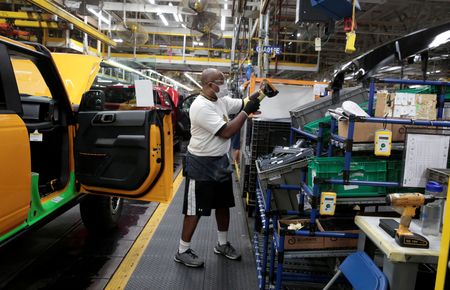By Lucia Mutikani
WASHINGTON (Reuters) – U.S. manufacturing output barely rose in August amid a decline in motor vehicle production, and activity could contract in the months ahead after the United Auto Workers (UAW) union embarked on strikes at three factories on Friday.
The strikes, which for now only involve 12,700 of the affected 146,000 UAW members, were launched at a time when manufacturing is already struggling under the weight of the Federal Reserve’s hefty interest rate increases, which have reduced demand for goods, typically bought on credit.
“The risk is that action broadens over coming days,” said Michael Pearce, lead U.S. economist at Oxford Economics. “We estimate a total walkout would reduce motor vehicle output by over 30%, which will begin to show up in the September report.”
Factory output edged up 0.1% last month after rebounding 0.4% in July, the Fed said on Friday. The gain was in line with economists’ expectations. Production was down 0.6% on a year-on-year basis in August.
Motor vehicle and parts output decreased 5.0%, almost reversing July’s 5.1% surge, when it benefited from difficulties adjusting the data for seasonal fluctuations related to annual plant shutdowns for new model retooling. Production of motor vehicles and parts was 5.9% higher on a year-on-year basis.
The UAW union began simultaneous strikes at three U.S. factories owned by General Motors, Ford and Chrysler parent Stellantis. These companies account for about two-thirds of domestic motor vehicle production.
Manufacturing, which makes up 11.1% of the economy, was already on the ropes because of slowing demand for goods and higher borrowing costs for businesses and consumers. Since March 2022, the U.S. central bank has raised its benchmark overnight interest rate by 525 basis points to the current 5.25%-5.50% range.
Excluding motor vehicles, factory output increased 0.6% last month after being unchanged in July. It was, however, 1.1% lower compared to August last year.
There were increases in the output of primary metals, machinery, aerospace and miscellaneous transportation equipment as well as furniture and related products.
But production of wood products declined as did that of nonmetallic mineral products, fabricated metal products, and electrical equipment, appliances and components.
The industrial action in the auto sector could disrupt supply chains and push up motor vehicle prices, and unsettle a disinflationary trend that was becoming entrenched.
A separate report from the Labor Department on Friday showed import prices increased 0.5% in August as the cost of fuels accelerated after nudging up 0.1% in July.
But import prices declined 3.0% in the 12 months through August after decreasing 4.6% in July. Annual import prices notched their 7th straight monthly drop.
Excluding fuels and food, import prices decreased 0.2%, matching the decline in July. These so-called core import prices dropped 1.3% on a year-on-year basis in August. They added to data this week showing core consumer and producer prices rose moderately in August, which suggests inflation is making steady progress toward the Fed’s 2% target.
Stocks on Wall Street were trading lower. The dollar fell against a basket of currencies. U.S. Treasury yields rose.
INFLATION EXPECTATIONS EASE
Consumers are also expecting inflation to subside in the coming year. A report from the University of Michigan showed consumers’ 12-month inflation expectations fell to 3.1% in September, the lowest since March 2021, from 3.5% in August.
They are just above the 2.3%-3.0% range seen in the two years prior to the pandemic. Consumers’ long-run inflation expectations dropped to 2.7%, falling below the 2.9%-3.1% range for the second time in the last 26 months.
The inflation news bolstered expectations the Fed would leave interest rates unchanged at the end of its Sept. 19-20 policy meeting.
But the auto strike and a recent raft of hefty union contracts, including one at United Parcel Service, have left some economists worried about wage pressures. Most, however, believe the Fed is done hiking rates.
“New headwinds to supply at a time when demand is picking up, disinflation from normalizing supply chains is coming to an end, and commodity prices are rising again would have clear inflationary risks,” said Veronica Clark, an economist at Citigroup in New York.
Mining output shot up 1.4% after falling 0.2% in July. Utilities production rose 0.9% after surging 4.4% in July as a heat wave across much of the country boosted demand for air conditioning. As a result, overall industrial production rose 0.4% in August after accelerating 0.7% in July.
Motor vehicles and parts account for just over 5% of industrial production.
“A complete shutdown of production for two weeks would weigh on industrial production around 1.9 percentage points and manufacturing production by around 2.5 percentage points in September,” Clark said. “Realistically, the initial drop in production is likely to be smaller, with some facilities still open and some intermediate production occurring.”
Capacity utilization for the industrial sector, a measure of how fully firms are using their resources, rose to 79.7% in August from 79.5% in July. It is in line with its 1972–2022 average. The operating rate for the manufacturing sector was unchanged at 77.9% last month and is three-tenths of a percentage point below its long-run average.
“Supply-chain problems that emerged following the pandemic have largely resolved, this is constraining manufacturers’ pricing power and has slowed goods inflation dramatically this year from 2021 and 2022, contributing to softer overall inflation,” said Gus Faucher, chief economist at PNC Financial in Pittsburgh, Pennsylvania.
(Reporting by Lucia Mutikani; Editing by Chizu Nomiyama, Andrea Ricci and Paul Simao)

